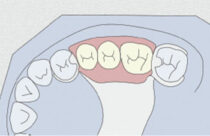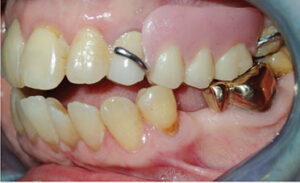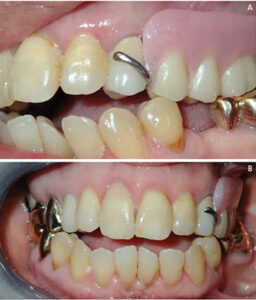 OBRADOVIC/ISTOCK/GETTY IMAGES PLUS
OBRADOVIC/ISTOCK/GETTY IMAGES PLUS
Esthetic Clasp Design for Removable Partial Dentures on Premolar Teeth
A clinical report examining restoration with a removable partial denture with an esthetic cast circumferential clasp on maxillary premolar teeth.
This course was published in the August 2019 issue and expires August 2022. The authors have no commercial conflicts of interest to disclose. This 2 credit hour self-study activity is electronically mediated.
EDUCATIONAL OBJECTIVES
After reading this course, the participant should be able to:
- Discuss esthetic considerations in clasp designs for removable partial dentures (RPD).
- Explain the design concept and indications for the cosmetic circumferential clasp for premolars with occlusal rest (what the authors call the C3PO design), and preparation considerations for the RPD appliance.
- Describe the clinical options presented to the patient in this case report and the advantages of treatment with the C3PO clasp design.
Circumferential (Akers) clasps on maxillary premolar teeth may not be esthetically acceptable to patients who require removable partial dentures (RPDs).1 Extracoronal and intracoronal precision attachments can be esthetic, but represent greater expense for the patient and are more difficult to fabricate and maintain.2 A mesial rest, proximal plate and I bar (or RPI) clasp,3,4 and a mesial rest, proximal plate and Akers (RPA) clasp5 can be used for maxillary posterior teeth, but may present unacceptable esthetics for patients with high lip lines or high smile lines. A modification to the RPA clasp has been described6 using a cast gold clasp engaging an undercut at the distofacial line angle of the maxillary canine and soldered to the partial denture framework, but fabrication of this clasp assembly is expensive and complex.

A wrought wire clasp engaging a proximal undercut and soldered to the partial denture framework is an esthetic alternative.7 Plunger attachments engaging a distal depression have been used;8 however, there may not be adequate space to place denture teeth. Rotational path designs for partial dentures9,10 can achieve excellent esthetic results for anterior tooth abutments, but they are difficult to adjust and are seldom used for distal extension RPDs.11 Tooth-colored polymer clasps, featuring acetyl and thermo-plastic resins, are used due to ease of fabrication and esthetics, but are not readily adjustable and have not demonstrated durability. Lingual retention and the elimination of the visible facial clasp arm have been proposed for premolars;12,13 however, canines may require the fabrication of a crown with milled surfaces that provide a deep rest and mesial lingual retentive area.14 A maxillary canine retainer with mesial groove reciprocation, mesiolingual rest, and distofacial depression retention has been described,15 but it may not be applicable to maxillary incisors. A round-rest, distal depression clasp was developed as an esthetic alternative to a conventional clasp for maxillary anterior teeth that serve as abutments for RPDs. The round-rest, distal depression clasp design was developed specifically for maxillary incisors or canine teeth.16
A cosmetic circumferential clasp for premolars with occlusal rest (CCCPO = C3PO) was introduced as an esthetic alternative to a conventional circumferential (Akers) clasp for RPD abutments. The C3PO clasp design was developed specifically for maxillary premolar teeth to minimize the display of metal components in the esthetic zone — generally, the facial aspects of the mesiobuccal cusp of the maxillary first molar and teeth anterior to it.
Indications for the C3PO clasp include abutments for RPDs when esthetic demands are high, conventional and polymer clasps are cosmetically unacceptable, and the patient lacks the financial capabilities for an intra- or extracoronal clasp-retained RPD. The C3PO design consists of a cosmetic circumferential cast clasp beginning at the guide plane minor connector on the distal aspect of a maxillary premolar, located at or above the survey line (height of contour) and engaging a mesiolingual undercut of 0.25 mm. The minor connector goes over the prepared distal marginal ridge into a prepared distal occlusal rest. The facial aspect of the minor connector may have a short arm extending to the distofacial line angle of the premolar to provide additional reciprocation if necessary. Support is provided by the occlusal rest. The bracing provided by the mesiolingual clasp arm, distal guide plane and optional short distofacial arm offer more than 180° encirclement around the tooth for stability. The terminal end of the mesiolingual clasp arm engages an undercut (0.25mm) for retention (Figure 1).

The C3PO is an esthetic alternative to a conventional Akers clasp (Figure 2). It also provides an alternative to a rotational path design, and with far less technical complexity. This clinical report describes a method of using a C3PO clasp to eliminate the display of metal on the labial surface of maxillary premolar teeth used as abutments for an RPD.

CLINICAL REPORT
A patient with a missing maxillary left second premolar, and a missing first and second molar presented to the clinic at the University of the Pacific Arthur A. Dugoni School of Dentistry. The patient was able to function with an existing RPD, but was bothered by the esthetics of the visible metal clasp (Figure 3).
The maxillary left lateral incisor was missing and previous orthodontic canine substitution had been performed. The maxillary canine was moved mesially and reshaped to substitute for the lateral incisor, the first premolar was moved to the canine position, and additional posterior teeth were also moved mesially. The patient had an anterior open bite and did not want implant-supported restorations.

premolar (in the arch position of the canine) prior to
cutting off the excess reciprocation arm on the
facial aspect of the abutment tooth.
Prior to RPD therapy, the patient’s chief complaint and medical, dental and social history were reviewed and considered noncontributory. Head and neck, paraoral, oral and radiographic evaluations were performed, with no significant findings. The patient had undergone caries risk assessment, as well as periodontal and restorative soft and hard tissue evaluations. No clinical or radiographic caries were detected. Adjunctive periodontal therapy and evaluation of initial therapy were completed, with prescription of a regular recall interval for additional periodontal evaluation and maintenance.
The patient had an existing maxillary cast chrome RPD that was in good repair and offered solid support, stability and retention. The patient, to whom finances were a major concern, was interested in an esthetic improvement regarding the visible metal clasp on the facial aspect of the maxillary left canine/premolar area. Three options were presented: a repeat conventional Akers clasp RPD, a rotational path design, and a C3PO design. The patient chose the C3PO design for esthetic reasons and ease of placement.

The diagnostic casts were surveyed and a maxillary RPD was designed with a broad palatal strap as a major connector, occlusal rests and embrasure clasps on molars on the right side, a C3PO clasp on the maxillary left first premolar, and occlusal rest with Akers clasp on the maxillary left third molar. The new RPD was designed to avoid the previous visible Akers clasp on the maxillary premolar by using a C3PO clasp to minimize metal display in the canine/premolar area.
PREPARATION FOR THE APPLIANCE
The guide planes on the distal of the premolar and mesial of the third molar abutments were prepared with a parallel chamfer tip carbide bur. Adjacent to the guide planes, marginal ridges were lowered 1.2 mm for the minor connector into the occlusal rest, which were placed with a No. 6 round bur in the distal fossa of the premolar, and No. 8 round bur in the mesial fossa of the third molar. The embrasure clasp on the other side was prepared for 1.5 mm of occlusal clearance and a 2.5 mm mesial distal dimension, lowering the marginal ridges in the interproximal embrasure between the first and second molars. The occlusal rests were refined. All occlusal rests were evaluated for minimum 1.5 mm occlusal clearance, and areas to receive the retention clasp arms were evaluated for adequate height of contour. If the required undercut (0.25 mm) was not available, tooth modification was planned by either odontoplasty or preparation of a depression or dimple to create an undercut with a No. 6 round bur. A ball burnisher was placed in the round rest seat and dimple depression to verify adequate preparation.

FABRICATION OF THE DENTURE
After completion of mouth preparations, an irreversible hydrocolloid impression was taken. The definitive cast was prepared in dental stone, tripodized, surveyed and designed. A cast chrome RPD framework was fabricated and tried intraorally and adjusted. The retentive values of this clasping design were comparable to Akers cast circumferential clasp or wrought wire.17–19 After maxillomandibular jaw relation records were completed, denture teeth were arranged and evaluated intraorally. Next, the denture base was processed and finished (Figure 4). After the denture was inserted, the reciprocation arm on the facial aspect of the premolar abutment was made shorter to stop near the distofacial line angle and render it minimally visible (Figures 5A and 5B and Figures 6A and 6B).

of the abutment tooth (A and B).
The patient was recalled twice each year. Comparing the previous Akers clasp RPD (Figures 7A and 7B) with the new design (Figures 8A and 8B), the patient was pleased with the functional and esthetic results of the new C3PO clasp RPD.

display on the facial aspect of the abutment tooth (A and B).
DISCUSSION AND SUMMARY
For the clinician, the C3PO clasp assembly described in this paper is no more technically demanding than a conventional Akers cast circumferential clasp for an RPD on maxillary premolar teeth. The dentist must plan the design of the RPD and perform detailed tooth modifications with a clear understanding of clasp function. The laboratory technician also must fabricate the framework with care and precision because any technical deviation may result in loss of retention of the clasp assembly.
The C3PO clasp is not recommended for abutment teeth with excessive mobility, and this clasp does achieve more than the recommended minimum 180° encirclement of the abutment. However, there is no stress release — therefore, it is not recommended as the terminal abutment for a distal extension RPD. The C3PO design is an alternative to the conventional Akers clasp, with the advantage of improved esthetics.
The C3PO concept is proposed as an esthetic clasp assembly for maxillary premolar teeth and canines. The clasp features a mesial lingual undercut for retention and a short bracing or reciprocating arm; in addition, retention is adjustable. The design satisfies the criteria for esthetics, retention, support and stability for a tooth-borne maxillary RPD.
Acknowledgement: The authors thank Jeffrey P. Miles, DDS, an associate professor at the University of the Pacific Arthur A. Dugoni School of Dentistry, for the illustrations.
REFERENCES
- Hansen CA, Iverson GW. An esthetic removable partial denture retention for the maxillary canine. J Prosthet Dent. 1986;56:199–203.
- Becerra G, MacEntee M. A classification of precision attachments. J Prosthet Dent. 1987;58:322–327.
- Kratochvil FJ. Influence of occlusal rest position and clasp design on movement of abutment teeth. J Prosthet Dent. 1963;13:114–124.
- Krol AJ. Clasp design for extension-base removable partial dentures. J Prosthet Dent. 1973;29:408–415.
- Eliason CM. RPA clasp design for distal-extension removable partial dentures. J Prosthet Dent. 1983;49:25–27.
- McMillan AS, Hunter N. An esthetic denture clasp for maxillary canine teeth. J Prosthet Dent. 1997;78:330.
- Belles DM. The Twin-Flex clasp: an esthetic alternative. J Prosthet Dent. 1977;77:450–452.
- Donovan TE, Derbabian K, Kaneko L, Wright R. Esthetic considerations in removable prosthodontics. J Esthet Restor Dent. 2001;13:241–253.
- King GE. Dual-path design for removable partial dentures. J Prosthet Dent. 1978;39:392–395.
- Krol AJ, Jacobson TE, Finzen FC. Removable Partial Denture Design: Outline syllabus. 5th ed. San Rafael: Indent; 1999:73–91.
- Donovan T. Use of the rotational path removable partial denture concept in a Kennedy Class II patient: a case report. J Esthet Restor Dent 2008;20:294–298.
- Pardo-Mindan S, Ruiz-Villandiego JC. A flexible lingual clasp as an esthetic alternative: a clinical report. J Prosthet Dent. 1993;69:245–246.
- De Rossi A, Albuquerque RF Jr, Bezzon OL. Esthetic options for the fabrication of removable partial dentures: a clinical report. J Prosthet Dent. 2001;86:465–467.
- Brudvik JS, Palacios R. Lingual retention and the elimination of the visible clasp arm. J Esthet Restor Dent. 2007;19:247–254.
- McCartney JW. The MGR clasp: an esthetic extracoronal retainer for maxillary canines. J Prosthet Dent. 1981;46:490–493.
- Tran C, LaBarre E, Landesman HM. A removable partial denture using an esthetically de-signed round-rest distal clasp on maxillary anterior abutment teeth: a clinical report. J Prosthet Dent. 2009; 102:286–289.
- Frank RP, Nicholls JI. A study of the flexibility of wrought wire clasps. J Prosthet Dent. 1981;45:259–267.
- Frank RP, Brudvik JS, Nicholls JI. A comparison of the flexibility of wrought wire and cast circumferential clasps. J Prosthet Dent. 1983;49:471–476.
- Ahmad I, Sherriff M, Waters NE. The effect of reducing the number of clasps on removable partial denture retention. J Prosthet Dent. 1992;68:928–933.
From Decisions in Dentistry. July/August 2019;5(7):36–39.




